 |
 |
 |
Our route - I:
02.09.03:
Bazargan
03.09.03 - 07.09.03:
Tabriz
08.09.03:
Zanjan
09.09.03:
Soltaniye
Qazvin
Saveh
10.09.03 - 11.09.03:
Kashan
12.09.03:
Abyaneh
13.09.03 - 17.09.03:
Esfahan
18.09.03 - 20.09.03:
Yazd
21.09.03 - 23.09.03:
Kerman
24.09.03:
Mahan
25.09.03 - 27.09.03:
Bam
28.09.03:
Mirjaveh
29.09.03:
Taftan (Pakistan)
Our route - II:
14.05.04 - 15.05.04:
Kerman
16.05.04:
Yazd
17.05.04:
Kashan
18.05.04 - 21.05.04:
Kelardasht
22.05.04:
Ramsar
Lahijan
Amir Bakandeh
23.05.04:
Bandar-e-Anzali
24.05.04:
Masuleh
25.05.04 - 26.05.04:
Tabriz
|
|
|
 |
| Iran |
 |
 |
 |
 |
 |
 |
On this page, we (will) describe our experiences in Iran.
Apart from the travelogue for this country
you will also find a number of links to useful sites,
ranging from general information to embassy homepages.
Content:
Part 1: 2003 (02.09.03 - 29.09.03)
Part 2: 2004 (14.05.04 - 26.05.04)
Part 1: 2003 (02.09.03 - 29.09.03)
Written by: Coen
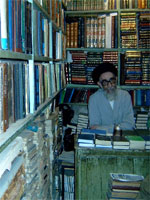 Early in the morning we drove to the Iranian border and with terror we saw the 2 km long row with waiting trucks. However we passed all the trucks, drove to the border and left Turkey quickly. At the Iranian customs, after finishing all the paperwork, we had to wait before a big fence. Every few minutes the gate was opened a bit and some people could pass through (the cigarette smugglers used this chance to run as quickly as possible through the opening). Our first experience in Iran was not so positive: a cigarette smuggler who dropped his cigarettes was completely beaten up by the Iranian border police.
Early in the morning we drove to the Iranian border and with terror we saw the 2 km long row with waiting trucks. However we passed all the trucks, drove to the border and left Turkey quickly. At the Iranian customs, after finishing all the paperwork, we had to wait before a big fence. Every few minutes the gate was opened a bit and some people could pass through (the cigarette smugglers used this chance to run as quickly as possible through the opening). Our first experience in Iran was not so positive: a cigarette smuggler who dropped his cigarettes was completely beaten up by the Iranian border police.
The first target in Iran was Maku because we had to change money. This turned out to be impossible and the next day we had to go back to the border. After changing money we drove to Tabriz.
With "Highway to Hell" from ACDC on the radio we drove the long and monotonous etappe through the desert with its many police controls.
80 % of the Iranians drive a Paykan, a copy of the English Hillman Hunter from the seventies and they drive rather impulsive. We passed an official billboard with the text "Down with USA" and we filled our tank (60 liter) for only 1 USD. The Iranians are all very friendly, they wave and stare. A few near-accidents happened because the traffic participants are so interested in us that they forget about the traffic. Everywhere on the road there are donkey carriages and small villages with clay houses and colorful painted window frames.
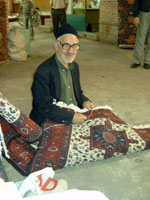 After arriving in Tabriz, we fought ourselves through the traffic where stoplights were ignored and everybody did whatever he/she liked. We went to the El Goli park, where we parked on a parking lot. In the evening we paraded around the lake and chatted with a lot of young people whose headscarves where nearly off their heads and some of whom even wore jeans. They are all very happy to talk to foreigners and some even take the risk to criticize their government in public. One guy even comes to our car and asks us to tell our media at home that their government are fascists.
After arriving in Tabriz, we fought ourselves through the traffic where stoplights were ignored and everybody did whatever he/she liked. We went to the El Goli park, where we parked on a parking lot. In the evening we paraded around the lake and chatted with a lot of young people whose headscarves where nearly off their heads and some of whom even wore jeans. They are all very happy to talk to foreigners and some even take the risk to criticize their government in public. One guy even comes to our car and asks us to tell our media at home that their government are fascists.
With Nasser from the tourist information and some other tourists we had a pick-nick in the El Goli park the next morning. This was mainly meant to offer young people the possibility to talk to foreigners (and to control what they were saying?!). Later that day we walked around by ourselves, which was more fun.
For Dorrit we bought one of these Iranian potato bags (after all she had to be in full hejab) because the Iranian men where staring a bit too much. For Dorrit's birthday we went to an expensive hotel and celebrated with alcohol-free beer, crisps and BBC-world. On her birthday we went to the bazaar and I bought her a nice new headscarf. In the afternoon we had Abgusht (lamb meat boiled with potatoes, vegetables and sheep fat from which you drink the bouillon first and then smash the rest with a masher and eat it with flat bread). When we crossed a road we saw Johann and Alex from Singapore, (we met them in Turkey) sitting in an Iranian car together with three Iranians. With them we drove to the modern part of Tabriz called "Champs Elysees" and had a wonderful evening meal.
The next day we went to the bazaar and the citadel and we decided to get a car insurance (you need one with the way they drive here..). In the evening we went to the cinema where we saw an Iranian movie about Iraki-Kurdish PKK-terrorists who attacked an Iranian village in Kordestan.
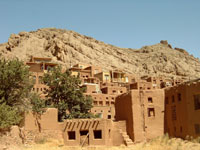 From Tabriz we drove via Zanjan along mountains, crevices and rivers. Beautiful landscape though very dry and hot. In Soltaniye we visited a mausoleum and after that we looked at a mausoleum in Qazvin, which had nice blue mosaics on the outside and mirrors on the inside. A funeral procession passed by with the typical open coffin and crying women following.
From Tabriz we drove via Zanjan along mountains, crevices and rivers. Beautiful landscape though very dry and hot. In Soltaniye we visited a mausoleum and after that we looked at a mausoleum in Qazvin, which had nice blue mosaics on the outside and mirrors on the inside. A funeral procession passed by with the typical open coffin and crying women following.
Via a dusty road we drove to Saveh. Many honking and waving Iranians who overtake and then slow down to be overtaken so that they can see as much of us as possible. A woman stumbled over a stake because she could not look at the street and at us at the same time.
On our way to Kashan we passed another holy complex with beautiful blue and yellow mosaic towers and a nice marble courtyard where Iranians picnicked or had a water pipe in the niches. We had to be on almost everybody's photo. A few 100 m away was a ruin of a real sand castle with walls made out of clay and grass.
We continue our tour to Kashan. A modern family stops to give us freshly harvested walnuts.
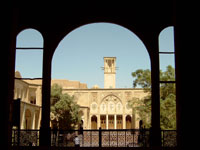 Kashan is a very nice city with an old town consisting completely of yellow clay houses, narrow streets and wind towers that collect the hot wind and cool it down with water. For hours on end we stroll through this still inhabited open air museum. Also a visit to one of the historical merchant houses was on the program and on our way through the bazaar we found a nice teahouse in an old bath house where we met Mikel en Christer from Norway.
Kashan is a very nice city with an old town consisting completely of yellow clay houses, narrow streets and wind towers that collect the hot wind and cool it down with water. For hours on end we stroll through this still inhabited open air museum. Also a visit to one of the historical merchant houses was on the program and on our way through the bazaar we found a nice teahouse in an old bath house where we met Mikel en Christer from Norway.
With a parrot on my shoulder we had tea, lying on a carpet with pillars in our back and served one delicacy after the other. In the evening we decided to go to the Fin park with Mikel and Christer to pick-nick between the Iranian families. Many of them strained their necks to see as much as possible...
Next day we drove to Abyaneh. Part of the route went through a lovely mountain area with sharp rock masses that lay in rows in a nice decor and looked like saw blades. The last part we drove through a green valley where the road twisted through the hills. We visited the UNESCO village Abyaneh, whose orange clay houses are build against the mountain slope with narrow streets and nice views through. It is full of colorful traditional costumes and donkey carriages. In the evening we drove to Esfahan and arrived in the dark.
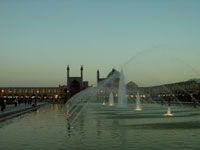 On our first day in Esfahan we stuck to the Emam Khomeini square. This giant square is absolutely fantastic; in the middle of the square there is a park with fountains, around it the "wall" is made out of arches with shops in it as well as the highlights of Esfahan; the beautiful mosques and palaces. Everywhere are groups of boys practicing their English on tourists and it is black with chadors. The next day we walked the route along the 3 famous broad pillar-bridges (the oldest dates from the 12th century) and because there is a cosy traditional teahouse in or next to every bridge, this took us a whole day.
On our first day in Esfahan we stuck to the Emam Khomeini square. This giant square is absolutely fantastic; in the middle of the square there is a park with fountains, around it the "wall" is made out of arches with shops in it as well as the highlights of Esfahan; the beautiful mosques and palaces. Everywhere are groups of boys practicing their English on tourists and it is black with chadors. The next day we walked the route along the 3 famous broad pillar-bridges (the oldest dates from the 12th century) and because there is a cosy traditional teahouse in or next to every bridge, this took us a whole day.
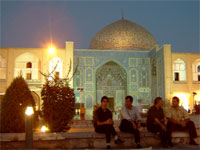 Furthermore we visited the huge Friday mosque (Jameh) with a marble mihrab and nice brick stone motives. In one of the teahouses we met Afshin, an English-student in Tehran and his fellow student Hassan. They invited us over to their home to drink wine. We accepted the invitation and drove to their village in an old Paykan. In the evening we watched illegal American video clips from Iranian artists and we played cards. Later that night we went to a deserted garden outside the village where we smoked water pipe at the campfire, danced on old Madonna music and discussed politics (after chasing away a wolf roaming the garden). We spent the night there and the next day we enjoyed a lovely meal. When we got back to the car the next day, a police officer was waiting for us; where had we been?!
Furthermore we visited the huge Friday mosque (Jameh) with a marble mihrab and nice brick stone motives. In one of the teahouses we met Afshin, an English-student in Tehran and his fellow student Hassan. They invited us over to their home to drink wine. We accepted the invitation and drove to their village in an old Paykan. In the evening we watched illegal American video clips from Iranian artists and we played cards. Later that night we went to a deserted garden outside the village where we smoked water pipe at the campfire, danced on old Madonna music and discussed politics (after chasing away a wolf roaming the garden). We spent the night there and the next day we enjoyed a lovely meal. When we got back to the car the next day, a police officer was waiting for us; where had we been?!
The program of the next day consisted of visiting the Sheik Lotfollah mosque in which you get quiet if you see the beautiful mosaics inside and outside. Also the Emam mosque was very impressive because of its splendor and hugeness.
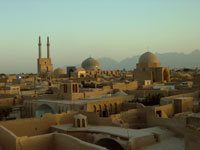 Our next station was Yazd, the road to get there was dusty. We found a good spot and spent the night with the Iranian owner and a girl from Japan. Yazd is another centuries-old clay city with wind towers, brightly colored mosaic-towers and minarets. In the city it is full of Afghans in their traditional dresses.
Our next station was Yazd, the road to get there was dusty. We found a good spot and spent the night with the Iranian owner and a girl from Japan. Yazd is another centuries-old clay city with wind towers, brightly colored mosaic-towers and minarets. In the city it is full of Afghans in their traditional dresses.
We enjoyed the view over the city from the roof of the Husseinia, spent an evening with other overlanders in the Malek hotel, a 200 year-old caravansary with a beautiful courtyard and we visited a Zoroastrian firetempel. Furthermore we strolled through the old city and chatted with Iranians in the teahouses.
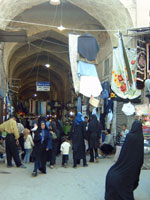 In Kerman we parked at a hotel (and for the first time in Iran we had a decent restaurant meal) and we walked over the old eastern bazaar with its exotic people and canvas cloths against the sun. We also went to the mausoleum with a nice garden and we examined an ice house. This is a sort of big clay beehive where they used to store the ice of the winter in summer. This city is very conservative with only black chadors and staring people. When I played my guitar in the evening, all of a sudden 3 guitars were stuck out of a window of an appartment and 4 members of a rock band invited me to get up. We chatted about English music - illegal in Iran - and Onish the bandleader gave me guitar lessons till 3.00 in the morning. The next day we first visited Yassi and Sina (friends of Onish) and then drove to the beautiful gardens of Mahan. The secret police wanted to hear us out again (happened a few times before) but the day was saved by a nice chat with a female medicine student. In the evening we were invited for dinner by Yassi and Sina (lots of kebab), who turn out to be a very modern and nice couple.
In Kerman we parked at a hotel (and for the first time in Iran we had a decent restaurant meal) and we walked over the old eastern bazaar with its exotic people and canvas cloths against the sun. We also went to the mausoleum with a nice garden and we examined an ice house. This is a sort of big clay beehive where they used to store the ice of the winter in summer. This city is very conservative with only black chadors and staring people. When I played my guitar in the evening, all of a sudden 3 guitars were stuck out of a window of an appartment and 4 members of a rock band invited me to get up. We chatted about English music - illegal in Iran - and Onish the bandleader gave me guitar lessons till 3.00 in the morning. The next day we first visited Yassi and Sina (friends of Onish) and then drove to the beautiful gardens of Mahan. The secret police wanted to hear us out again (happened a few times before) but the day was saved by a nice chat with a female medicine student. In the evening we were invited for dinner by Yassi and Sina (lots of kebab), who turn out to be a very modern and nice couple.
 Our last target in Iran was Bam. The road cuts completely through the desert and Bam is a huge palm oasis in the middle of this desert. The first day we spent with Christoph, a Bavarian we met 4 times before, and rolled out our pick-nick mat in the middle of a date palm field. Chicken with dates was on the menu and we relaxed all afternoon.
Our last target in Iran was Bam. The road cuts completely through the desert and Bam is a huge palm oasis in the middle of this desert. The first day we spent with Christoph, a Bavarian we met 4 times before, and rolled out our pick-nick mat in the middle of a date palm field. Chicken with dates was on the menu and we relaxed all afternoon.
Also in Bam the people are very conservative and not all of them are friendly but the Bam castle makes up everything. The citadel in the middle is build on a rock and the clay city is around it. The city is walled in by a very long castle wall with cants and every 300 meter there is a watchtower. From the towers you have an amazing view over the city in the middle of the oasis and over the surrounding desert.
The last day we drove the desert road to Mirjaveh at the Pakistan border. A very heavy wind blew the desert sand in lines over the asphalt. This gradually turned into a sand storm and the sand entered the car through every possible opening.
When the sand storm lifted, the blue sky stood out beautifully against the brownish and yellowish rocks in the afternoon sun and some camels at the roadside looked at us questioning why we left Iran after only one month...
Coen
Part 2: 2004 (14.05.04 - 26.05.04)
Written by: Dorrit
 We started at 4:30 in the morning, just like the days before. Four hours later we were at the border and another two hours getting stamps here and getting stamps there after that we could finally enter Iran. The rest of the day was like a kind of hell: the outside temperature hovered around 46°C and due to a sandstorm that raged for the rest of the day we had to keep all windows closed so that the car became an oven at 54°C. I had to pour water over the dogs to keep them from overheating. For 400 km we drove through the endless sandy plains of the (Iranian) Baluchistan desert. We saw nearly no traces of life other than a car or two passing us by. Everything was brown; the sky, the desert, the car. There was sand everywhere, even between our teeth! The sun was a slightly paler brown circle in an otherwise dark brown sky, which looked rather apocalyptic.
We started at 4:30 in the morning, just like the days before. Four hours later we were at the border and another two hours getting stamps here and getting stamps there after that we could finally enter Iran. The rest of the day was like a kind of hell: the outside temperature hovered around 46°C and due to a sandstorm that raged for the rest of the day we had to keep all windows closed so that the car became an oven at 54°C. I had to pour water over the dogs to keep them from overheating. For 400 km we drove through the endless sandy plains of the (Iranian) Baluchistan desert. We saw nearly no traces of life other than a car or two passing us by. Everything was brown; the sky, the desert, the car. There was sand everywhere, even between our teeth! The sun was a slightly paler brown circle in an otherwise dark brown sky, which looked rather apocalyptic.
The desert does not end before Bam, or what is left of Bam after the devastating earthquake last Christmas. Which is not much. The town looks as if it has been bombed. There is not a single house that is not reduced to rubble, the surviving inhabitants (about half of the original 80,000) live in tents or containers. The sand storm was still raging and some of the tents had collapsed or been blown away. People were running to and fro to collect their belongings. Palm trees were broken or blown down and everything was brown.
The problem seems to be that there was no land register, so only the foundations of the houses indicate which bit of land belongs to whom and how big the pieces are. The inhabitants, afraid that their bit of land will be taken away from them, are defending the ruins and refuse to clear them.
Although it was 17:30 and we had been on the road since 4:30 am we did not want to bother anyone here about a safe place to sleep and decided to drive on to the next settlement in the desert: Kerman. That is another 200 km down the road, but at least here in Iran we can drive after dark again: the roads are in perfect shape and there are no donkey-, oxen- or hand carts, chicken, cows, horses, camels, elephants, monkeys, cyclists, pedestrians or other unlit objects on the road as there were on the Indian subcontinent.
15 hours, 1000 km and a border crossing after leaving Dalbandin that morning we arrived in Kerman, it was 19:30. At 1750m it was refreshingly cool and sand storm free, at last we could sleep in our own bed, on soft cushions instead of having to sleep on a mat outside.
 We took a day off in Kerman, doing this and that and Coen went to Kerman's bazaar with Manuel, a Swiss architect on a study trip to Iran. We were invited for a traditional Iranian dinner by our friends Arianus, Sina and Yassi, who we have met last time we were here.
We took a day off in Kerman, doing this and that and Coen went to Kerman's bazaar with Manuel, a Swiss architect on a study trip to Iran. We were invited for a traditional Iranian dinner by our friends Arianus, Sina and Yassi, who we have met last time we were here.
Our original plan to drive north via Shiraz and Persepolis was abandoned as it would mean a detour of at least 700 km. After so many days of driving the idea of such a big detour was more that we could stomach (we regretted this later, of course). We took the shortest route up north and included a return visit to Yazd, where we enjoyed the view over the roofs of the city with Manuel and had a delicious dinner in an old caravan saray, and to Kashan, where again we could not find a good place to stay and were being surrounded by a crowd of spectators that made us feel we had not left India after all. We did however manage to go the Dellpazir restaurant that was recommended to us last time and it was indeed very good.
The larger part of this Iran visit though, we spent at the Caspian sea coast. The further we got up north the greener the hills became. We enjoyed the cool air and green landscape of Kelardasht, justly called "Iran's paradise". It is a wonderful area with its grassy hills full of yellow and purple flowers, its dark forests and its cute little villages. In the background loom the white peaks of the Alborzt-range with Iran's highest peak, Mt Damavand (+5000m). We felt as if we are sitting on a Swiss summer pasture. We parked the van in a field and camped for a few days between the flowers; the best way to recover from all the sand and the heat of the last week. On the radio we heard that an angry crowd was attacking the British embassy (for want of a US-embassy, which has been thrown out of Iran some 20 years ago) in Tehran, less than 100 km away from us. The reason seemed to be the crusade of the "Knights Against Terror" against the Shiite holy sites Karbala and Najaf in Iraq.
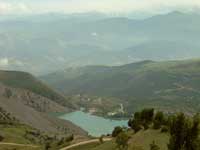 We drove another 20 km and parked in another field, one with a view over a lake some 100m below us, at which banks Iranians are picnicking. Here we had our first rain and fog since ages and enjoyed it.
We drove another 20 km and parked in another field, one with a view over a lake some 100m below us, at which banks Iranians are picnicking. Here we had our first rain and fog since ages and enjoyed it.
The road to the coast went right through a marvellously green spring forest that could have been anywhere in Europe. When it started drizzling the likeness with (Northern) Europe was even stronger and we wallowed in Euro nostalgia.
The coast - it was the first time since Goa (India) that we saw the sea again - was quite disappointing. From the road you can hardly see the sea, because the entire coast line has been "developed" with rows and rows of 4m² wooden holiday shacks and kitschy palaces with mirroring windows and bright-pink ornaments. Other than that it is dirty and grey. We gave it one look and then returned to our green forested hills some 10 km away from the coast. Here it became beautiful again; the forests were accompanied by endless green tea plantations and rice fields. Cute villages feature simple little houses with chicken, geese, rusty cars of the 1930s and women in 5 layered skirts, woollen vests and brightly coloured head scarves in the yard. There was not one chador (black, all covering dress that women are supposed to wear, chador litteraly means "tent") to be seen. Children were using a tree stick to roll a bicycle wheel in front of them - as if they were practicing for a movie about the 19th century. Old men were sitting on their porches smoking their pipes, the rest of the village was busy harvesting the tea in big wicker baskets. Nothing made us think we were in Iran, it looks a lot more like Romania if anything.
We continued to the highly recommended mountain village of Masuleh, but were not impressed. It is very touristy and the locals seem a little spoilt. We found none of the usual Iranian hospitality here, everyone is only interested in making money out of you. We had a few fights, e.g. when we were asked EUR 20 for one night parking on a little stripe of grass at the roadside. That is about one tenth of a monthly salary (gross) in Iran. In the forests around Masuleh there were fantastic hiking possibilities however, which we used extensively.
 Slowly we drove back to Tabriz, stopping on the way whenever we found a good place to stay and hike in the forested hills. In Tabriz we parked at the El Goli park and just like last time we were nearly overrun by interested Iranians who wanted to talk to us. It was a pleasant evening. Talking to the locals in Iran is a lot different than in Pakistan or India, where most people are only interested in how much our camper has cost us and how much salary we earn per month. People here usually want to talk about Iran, which is a lot more interesting for us.
Slowly we drove back to Tabriz, stopping on the way whenever we found a good place to stay and hike in the forested hills. In Tabriz we parked at the El Goli park and just like last time we were nearly overrun by interested Iranians who wanted to talk to us. It was a pleasant evening. Talking to the locals in Iran is a lot different than in Pakistan or India, where most people are only interested in how much our camper has cost us and how much salary we earn per month. People here usually want to talk about Iran, which is a lot more interesting for us.
Among those who addressed us was Ali, a 20 year old who had lived all his life in Munich but had been brought back to Iran by his dad. We chatted a little and agreed to meet up with him and his cousin Aidin and visit the bazaar the next morning. We visited silver smith after silver smith and finally found a great gift for the wedding of Coen's sister. We drank a tea and smoked a water pipe together and were brought back to our camper van by Ali's dad in his 1965 Chevrolet, sitting on red leather seats and watching the mini-TV on the dashboard. And then it was already time to say goodbye, not only to Aidin, Ali and his dad, but also to Iran. We did not arrive at the border before 18:30 and feared for that can of Efes-beer we had promised ourselves, until we realized it was an hour and a half earlier in Turkey. Nobody wanted to search the car and we were allowed to drive past the enormous line of waiting cars, so that we were through before we knew it. The last impression of Iran was clearly better than the first.
Dorrit
|
 |
|
 |
 |
 |
 |
Our top 5: |
 |
 |
1. Yazd
2. Esfahan
3. Bam
4. Abyaneh
5. Kashan
|
 |
 |
 |
 |
 |
 |
 |
 |
TIP |
 |
 |
Visa: you can get a one month tourist visa for Iran within one week for only USD 16 in Trabzon (Turkey)!
In Ankara you get the same visum within 10 days for USD 50 (with Dutch nationality).
|
 |
 |
 |
 |
 |
 |
 |
 |
TIP |
 |
 |
If you have a tourist visum and a carnet de passage you do not have to pay diesel tax in Iran.
However, the custom officers may try to ask you for it.
|
 |
 |
 |
 |
 |
 |
 |
 |
TIP |
 |
 |
Do not blow your nose in a restaurant in Iran. For other guests in the restaurant, this is reason enough to stop eating.
|
 |
 |
 |
 |
 |
 |
 |
 |
TIP |
 |
 |
In the bookshops of Tabriz you can buy the Lonely Planet Iran for only EUR 5.
An illegal copy, of course..
|
 |
 |
 |
 |
 |
 |
 |
 |
TIP |
 |
 |
Good food you get in Tabriz at "Ya Ali" on Qods street, opposite of the mosque west of the bazaar, in de basement of a shopping arcade.
Ask the locals for directions, everyone knows the place.
|
 |
 |
 |
 |
 |
 |
 |
 |
TIP |
 |
 |
When we visited Soltaniye near Zanjan (autumn 2003) they were still restoring the place.
Although there was nothing to see, entry was still EUR 3 p.p.
|
 |
 |
 |
 |
 |
 |
 |
 |
TIP |
 |
 |
Not in any of the travel guides, but highly recommendable is the cute tea house half way up the bazaar of Kashan, in an old bath house.
One of the best tea houses of Iran!
|
 |
 |
 |
 |
 |
 |
|


